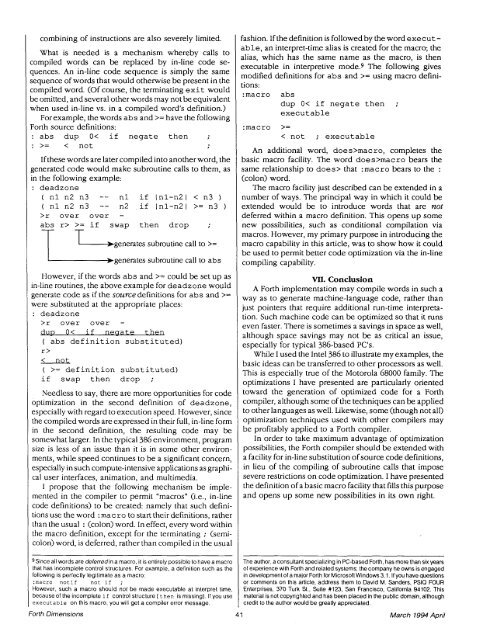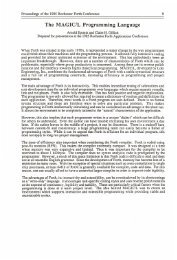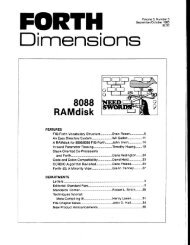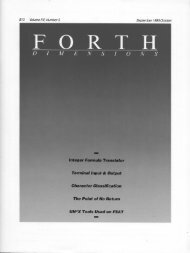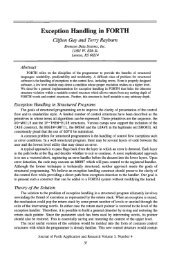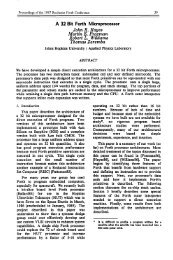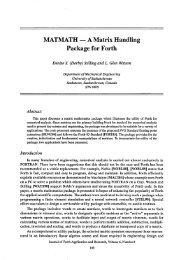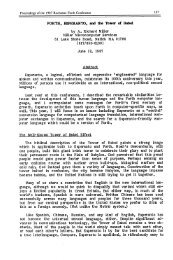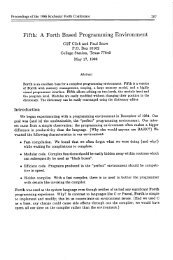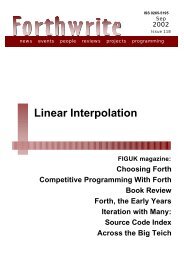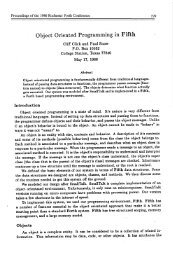FAST Forth Native-Language Embedded Computers
FAST Forth Native-Language Embedded Computers
FAST Forth Native-Language Embedded Computers
Create successful ePaper yourself
Turn your PDF publications into a flip-book with our unique Google optimized e-Paper software.
combining of instructions are also severely limited.<br />
What is needed is a mechanism whereby calls to<br />
compiled words can be replaced by in-line code sequences.<br />
An in-line code sequence is simply the same<br />
sequence of words that would otherwise be present in the<br />
compiled word. (Of course, the terminating e xit would<br />
be omitted, andseveral other words may not be equivalent<br />
when used in-line vs. in a compiled word's definition.)<br />
For example, the words abs and >= have the following<br />
<strong>Forth</strong> source definitions:<br />
: abs dup 0< if negate then ;<br />
: >= < not<br />
If these words are later compiled into another word, the<br />
generated code would make subroutine calls to them, as<br />
in the following example:<br />
: deadzone<br />
( nl n2 n3 -- nl if lnl-n21 < n3 )<br />
( nl n2 n3 -- n2 if 1x11-n21 >= n3 )<br />
>r over over -<br />
abs r> >= if then drop ;<br />
T ILwap<br />
U g e n e r a t e s<br />
generates subroutine call to >=<br />
subroutine call to abs<br />
However, if the words abs and >= could be set up as<br />
in-line routines, the above example for deadzone would<br />
generate code as if the source definitions for abs and >=<br />
were substituted at the appropriate places:<br />
: deadzone<br />
>r over over -<br />
dup O< if neaate then<br />
( abs definition substituted)<br />
r ><br />
< not<br />
( >= definition substituted)<br />
if swap then drop ;<br />
Needless to say, there are more opportunities for code<br />
optimization in the second definition of deadzone,<br />
especially with regard to execution speed. However, since<br />
the compiled words are expressed in their full, in-line form<br />
in the second definition, the resulting code may be<br />
somewhat larger. In the typical 386 environment, program<br />
size is less of an issue than it is in some other environments,<br />
while speed continues to be a significant concern,<br />
especially in such compute-intensive applications as graphical<br />
user interfaces, animation, and multimedia.<br />
I propose that the following mechanism be implemented<br />
in the compiler to permit "macros" (i.e., in-line<br />
code definitions) to be created: namely that such definitions<br />
use the word :macro to start their definitions, rather<br />
than the usual : (colon) word. In effect, every word within<br />
the macro definition, except for the terminating ; (semicolon)<br />
word, is deferred, rather than compiled in the usual<br />
fashion. If the definition is followed by the word execut -<br />
able, an interpret-time alias is created for the macro; the<br />
alias, which has the same name as the macro, is then<br />
executable in interpretive mode.9 The following gives<br />
modified definitions for abs and >= using macro defini-<br />
tions:<br />
:macro<br />
abs<br />
dup 0< if negate then ;<br />
executable<br />
:macro >=<br />
< not ; executable<br />
An additional word, does>macro, completes the<br />
basic macro facility. The word does>macro bears the<br />
same relationship to does> that :macro bears to the :<br />
(colon) word.<br />
The macro facility just described can be extended in a<br />
number of ways. The principal way in which it could be<br />
extended would be to introduce words that are not<br />
deferred within a macro definition. This opens up some<br />
new possibilities, such as conditional compilation via<br />
macros. However, my primary purpose in introducing the<br />
macro capability in this article, was to show how it could<br />
be used to permit better code optimization via the in-line<br />
compiling capability.<br />
W. Conclusion<br />
A <strong>Forth</strong> implementation may compile words in such a<br />
way as to generate machine-language code, rather than<br />
just pointers that require additional run-time interpretation.<br />
Such machine code can be optimized so that it runs<br />
even faster. There is sometimes a savings in space as well,<br />
although space savings may not be as critical an issue,<br />
especially for typical 386-based PC's.<br />
While I used the Intel 386 to illustrate my examples, the<br />
basic ideas can be transferred to other processors as well.<br />
This is especially true of the Motorola 68000 family. The<br />
optimizations I have presented are particularly oriented<br />
toward the generation of optimized code for a <strong>Forth</strong><br />
compiler, although some of the techniques can be applied<br />
to other languages as well. Likewise, some (though not all)<br />
optimization techniques used with other compilers may<br />
be profitably applied to a <strong>Forth</strong> compiler.<br />
In order to take maximum advantage of optimization<br />
possibilities, the <strong>Forth</strong> compiler should be extended with<br />
a facility for in-line substitution of source code definitions,<br />
in lieu of the compiling of subroutine calls that impose<br />
severe restrictions on code optimization. I have presented<br />
the definition of a basic macro facility that fills this purpose<br />
and opens up some new possibilities in its own right.<br />
gSince all words are deferredin a macro, it is entirely possible to have a macro<br />
that has incomplete control structures. For example, a definition such as the<br />
following is perfectly legitimate as a macro:<br />
:macro notif not if ;<br />
However, such a macro should not be made executable at interpret time,<br />
because of the incomplete i f control structure ( then is missing). If you use<br />
executable on this macro, you will get a compiler error message.<br />
-- ~p<br />
The author, a consultant specializing in PC-based <strong>Forth</strong>, has more than six years<br />
of experience with <strong>Forth</strong> and related systems; the company he owns is engaged<br />
in developmentof a major <strong>Forth</strong> for Microsoft Windows 3.1. If you have questions<br />
or comments on this article, address them to David M. Sanders, PSI0 FOUR<br />
Enterprises, 370 Turk St., Suite #123, San Francisco, California 94102. This<br />
material is not copyrighted and has been placed in the public domain, although<br />
credit to the author would be greatly appreciated.<br />
<strong>Forth</strong> Dimensions 4 1 March 1994 April


